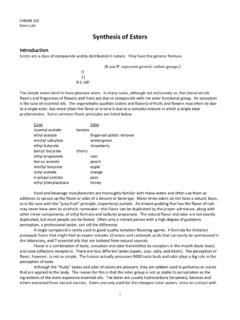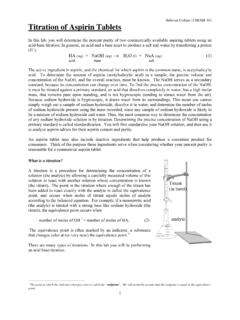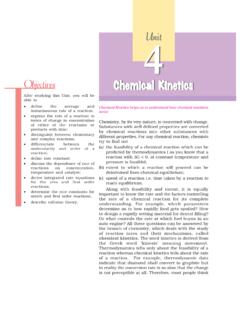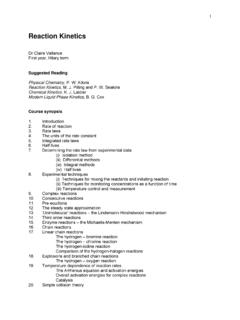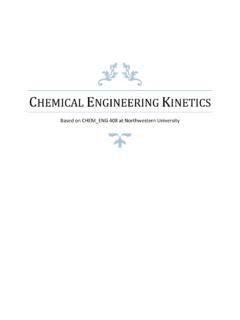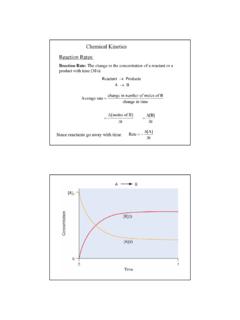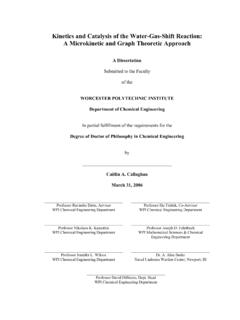Transcription of Bellevue College 162 Lab Manual Reaction Kinetics: The ...
1 Bellevue College | Chemistry 162 Lab Manual Chem& 162 ~ Reaction kinetics : An Iodine Clock Reaction 1 Reaction kinetics : The Iodine Clock Reaction Introduction The clock Reaction is a Reaction famous for its dramatic colorless-to-blue color change, and is often used in chemistry courses to explore the rate at which reactions take place. The color change occurs when I2 reacts with starch to form a dark blue iodine/starch complex. The ability to record the time at which the blue complex appears allows the rate of Reaction to be determined accurately with a stopwatch. In this experiment, the rate law for a Reaction is determined using the method of initial rates. The effect of concentration on the rate of this Reaction is determined by measuring the initial Reaction rate at several reactant concentrations.
2 You will also examine the effect of a metal ion catalyst on the Reaction rate. Lastly, you will investigate the effect of temperature on the rate of this Reaction , which will allow you to determine the activation energy. The Clock Reaction The primary Reaction to be studied is the oxidation of I- by S2O82- (persulfate) in aqueous solution: 2I-(aq) + S2O82-(aq) I2(aq) + 2SO42-(aq) (slow, rate determining) Equation 1 This Reaction will be run in the presence of a known amount of S2O32- (thiosulfate), which reacts very rapidly with I2. As long as S2O32- is present, I2 is consumed by S2O32- as fast as it is formed. This competing Reaction prevents the I2 produced from our Reaction of interest from reacting with starch, so no color change is observed until the thiosulfate is completely used up.
3 The "clock" Reaction is the Reaction of a very small amount of S2O32- (thiosulfate) with the I2 produced in the primary Reaction : I2(aq) + 2S2O32-(aq) 2I-(aq) + S4O62-(aq) (fast) Equation 2 The clock Reaction will signal when the primary Reaction forms a specific amount of I2. The amount of I2 formed before the color change can be calculated from the known amount of S2O32- added using the molar ratio in Equation 2. To find the rate of Equation 1, the change in the concentration of I2 is monitored over time. Below, [I2] is the change in the concentration of I2, and t represents the change in time: Rate = t][I2 Equation 3 Recall: Rate = 1/2 = = - 1/2 As soon as all of the S2O32- ions have reacted, the I2 still being formed (Equation 1) starts to accumulate and reacts with starch.
4 Starch serves as an indicator to help us see the I2, since the interaction between starch and I2 forms a blue starch-iodine complex. Thus, " t" is simply the time elapsed between mixing the reagents and the appearance of the blue color. Because the S2O32- ion concentration in the Reaction mixture is known, you can calculate " [I2]" using the stoichiometry of the clock Reaction . Since the same amount t ][I Bellevue College | Chemistry 162 Lab Manual Chem& 162 ~ Reaction kinetics : An Iodine Clock Reaction 2of S2O32- is added to each run, [I2] is also the same for each run. However, the amount of time for the appearance of the blue color varies with initial reactant concentrations, with temperature, and in the presence of catalyst, so t is not constant.
5 Notes Regarding the Initial Concentrations, the Dilution Formula, and Ion Molarities: The initial concentrations of reactants are calculated for the moment at which they are mixed. At that time, the solutions have mutually diluted each other (raised the volume of total solution, with or without adding moles of the solute), but have not yet started disappearing from solution (via Reaction ). For each ion in solution, a new molarity must be calculated that takes into consideration the new total volume of the solution, and the other ions that were added. The concentrations and volumes of the reactants are given in Table 1. To determine the concentration of an ion in solution, consider the stoichiometric relationship between the ionic compound and the number of ions formed in solution.
6 For example, a M solution of KI releases M I- and M K+ ions. The situation would be different if the source of I- was CaI2, since 2 moles of I- ions would be released for each mole of CaI2 that dissociates. Calculate the concentration of each reactant after combining the solutions, but before the chemical Reaction begins. Note that the total volume of each solution is 20 mL. Thus, in the dilution formula, M1V1 = M2V2, V2 is always 20 mL, and V1 is the volume of the individual solution added to the mixture. Preliminary Calculations Involving the "Clock Reaction Using the dilution formula, the concentration of S2O32- in the mixture is x10-3 M. According to the stoichiometry of the clock Reaction in Equation 2, the number of moles of I2 is one-half the the number of moles of S2O32.
7 The blue color will appear when x10-4 M of I2 (with two significant figures) has been formed by the primary Reaction . This number remains constant in all Runs, and so provides [I2] in all of rate calculations. All Runs: [I2] = x 10-4 M I2 Reaction Rate The rate law for Equation 1 will be determined by measuring the initial rate of Reaction with varying initial reactant concentrations. The concentration of S2O32- in the Reaction mixture is very small compared to the other reactants present, such that the measured rate is the initial rate of the Reaction . The rate law for Equation 1 is given below: Rate = k[I-]x [S2O82-] y Equation 4 In Equation 4, k is the rate constant, and x and y represent the order of I- and S2O82-, respectively.
8 These values will be determined experimentally from your data. Note: When the solution turns blue, only a very small percentage of the reactants have been used up. Thus, the initial concentrations of reactants can be used in the rate law with very little error. Typically, the error is less than 5%. Bellevue College | Chemistry 162 Lab Manual Chem& 162 ~ Reaction kinetics : An Iodine Clock Reaction 3 Effect of Concentration on the Reaction Rate: Finding the Rate Law For Runs 1-3, the initial I- concentration is varied while the initial S2O82- concentration remains constant. The order with respect to I- is determined using the method of initial rates. The following example will illustrate how to find a Reaction order using the method of initial rates.
9 Example: The following data was obtained for the Reaction : A + B C Experiment [A], M [B], M Rate (M/s) 1 2 3 The general rate law for this example is Rate = k[A]x[B]y Since [A] changes between Experiment 1 and 2, while [B] remains constant, the order for A is obtained by taking the ratio of the rates from these two experiments: ][k[ ].10][k[ ]M/s1M/s0020801 .. Since k is constant at a given temperature and [B]y is constant for Experiments 1 and 2, the equation simplifies to: [ ][ ]M/s1M/s20801 or = Thus, x = 1 for this example. Unfortunately, experimental results are not usually that "clean", and a more sophisticated method is needed to find x.
10 Mathematically, solving for exponents requires the use of logarithms. Taking the log of both sides of the equation above yeilds: Rearranging this equation to solve for x yields x = = 1 Experiments 2 and 3 may then be used to find the order for B, as shown below ][k[ ].25][k[ ]M/sM/s008012511 .. By cancelling out the common terms and dividing the rate and concentration values, we obtain = Taking the log of both sides and rearranging to solve for y gives y = = 2 For Runs 2, 4, and 5, the initial S2O82- concentration will vary while the initial I- concentration remains constant. Use the initial rates method shown above to find the order for S2O82- . Bellevue College | Chemistry 162 Lab Manual Chem& 162 ~ Reaction kinetics : An Iodine Clock Reaction 4 Once the values for x and y are known, these can be substituted back into Equation 4, and the rate constant (k) calculated for each set of initial concentrations.
